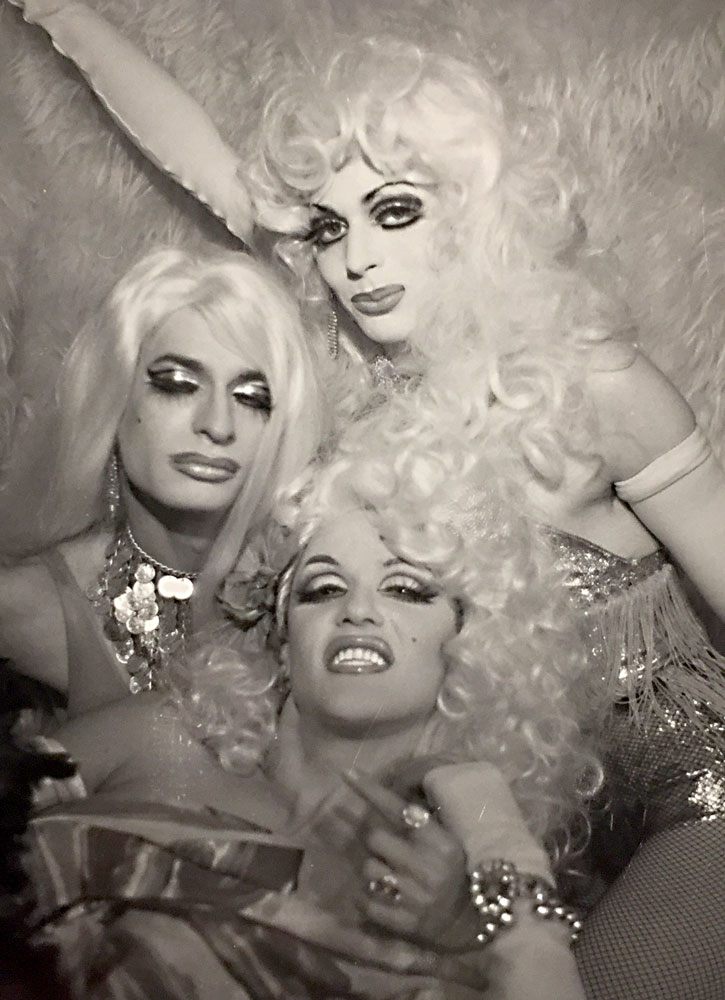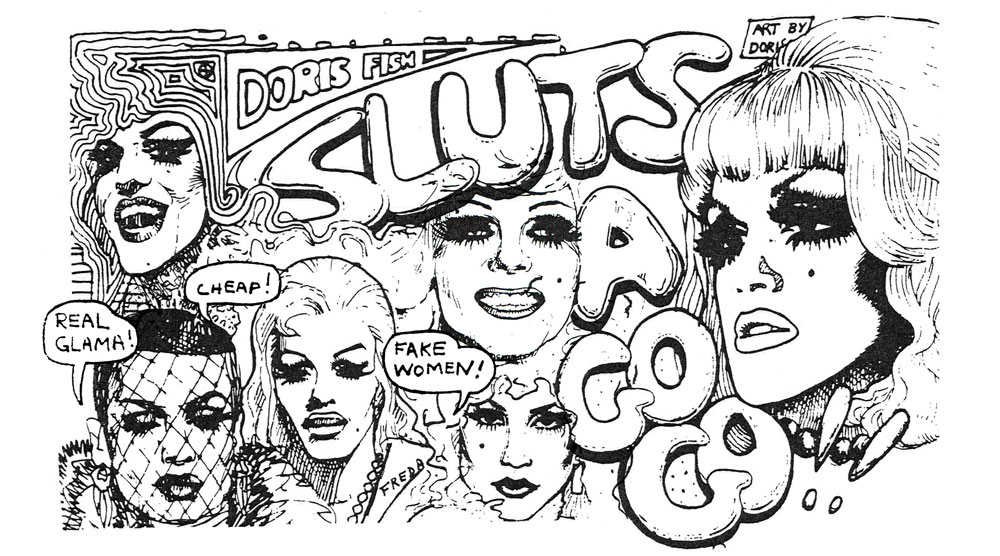A longtime fan of Doris Fish and the Sluts A Go-Go, I was inspired by their legacy when I was first exploring my gender identity in San Francisco in the early 1990s. Many years later, after I went through gender transition, my fascination was renewed thanks to reconnecting with my friends in the San Francisco drag community including the original Slut, Miss X, as well as Ms Bobbie Davis, who was a lover to Tippi at the end of her life and who has spent decades collecting and studying transgender history (Her collection is now the Louise Lawrence Transgender Archive.
The publication of Craig Seligman’s biography of Doris, “Who Does That Bitch Think She Is?: Doris Fish and the Rise of Drag” and my involvement as exhibit designer for the GLBT Historical Society Museum exhibit “Doris Fish: Ego As Artform” led me to start the website DorisFish.com in partnership with Phillip R. Ford, a regular Sluts collaborator and the director of their film “Vegas In Space”.
As a trans woman in 2023, this obsession with a group of old drag queens may seem a bit unusual, but I find a lot to draw from it.
One of the things that attracts me to the Sluts A Go-Go is the way they directly reflect the wide diversity of trans feminine gender expression: Doris Fish was very much a gay man with no interest in being seen as a woman. Miss X was an openly bisexual man (an “omnisexual satyr” as Craig Seligman describes her) who dated cis women and went on to a life of marriage to a cis woman and of fatherhood. Tippi, who seems to have experienced severe gender dysphoria and would today certainly be described as a straight trans woman. (I think drag was a kind of armor for Tippi, she seems to have only felt safe when she was on stage.)

Add to that the diverse cast of characters surrounding the Sluts: Freda Lay, Sandel Kincade, and other cis women were welcomed to the group as drag performers. Jaqueline Hyde, one of Doris’ best friends, lived as a woman. Ambisextrous was the original non-binary queer (all due respect to the Cockettes and Angels of Light) in his glittery beards, gender queer drag, and total disinterest in the art of female impersonation. Phillip R Ford was a flamboyant yet masculine gay man in a world of Castro Clones.
They all mixed together in a riot of subversive art and aggressive non-conformity. They pissed off a lot of people, gay AND straight, but they also had a devoted following in their time and they helped foster a more open view of art, gender and sexuality that outlasted them.
Today, the transgender “community” seems very fractured to me. There is a lot of tension and ambivalence between the various expressions. Many trans women are uncomfortable with Drag, for instance, because they feel that it is play acting (or parodying) femininity, treating it like a costume when the average transwoman just wants to be seen as a woman and does not have the luxury of taking off the costume.
General societal ignorance of the difference between the two is still a major problem. The fact that anti-trans laws and anti-drag laws have arisen simultaneously is evidence of this. They are entirely different things, but the average person just sees “men dressing like women” and all of it as a threat to the status quo. Acceptance of gender diversity in mainstream society under any circumstances is considered a threat to the Republic to many foolish and dangerous people.
Within the LGBT community this has also been a divisive issue. Historically, the boundary between drag queens and transsexuals was more permeable than it is now.
In the early days (1950s and 60s) trans women, particularly trans women sexually attracted to men, really only had one option if they wanted to go out in public, and that was to go to gay bars where they were somewhat tolerated. Additionally, someone choosing to live as a “straight” woman was seen as a denial of gay male identity at a time when gay males were fighting for their rights.
There were transvestite social organizations, like Virginia Prince’s group which published “Transvestia” magazine and was an important resource for the early trans community, or the famous Casa Susanna, that catered to the married heterosexual cross dresser but which actively discouraged both sex with men and medical transition.
This is to say nothing of the hostile reception lesbian and bisexual trans women received from the lesbian/feminist community….
In both cases, respectability politics were a problem.
Drag was seen by many as an impediment to mainstream acceptance of homosexuality. Drag Queens made the community “look bad” at a time it was trying to get society to accept homosexuals as regular, decent, tax-paying citizens. The rise of the hyper-masculine gay male as a reaction against being labeled as “sissies” further complicated things, pushing the trans feminine to the margins within the gay community.
The heterosexual cross dressers, on the other hand, were focused on normalizing transvestism as a healthy heterosexual behavior practiced by red-blooded men.
This is why many trans women who transitioned usually retreated into the stealth closet whoever possible. There was no place for them, nothing to do except hope that they could pass and live as a woman in straight society. (Often that was a luxury afforded only to privileged, white trans women.) They were neither drag queens nor cross dressers and they just wanted to be left alone. Who can blame them?
I think something is missing from the contemporary trans experience. I think there is value in subverting ALL of the norms: straight, gay/lesbian AND trans. We lose our collective power in all of this divisiveness. After all, we are all the same to our enemies, they don’t see the distinctions between us.
Doris was amused by the quest to become a “real woman”. She gleefully used the term “Fake Women” to describe herself and other trans feminine people, but she seems to have been a true ally and a generous friend to transsexuals. She was on a mission to celebrate and encourage outrageous gender nonconformity (as much as she was on a mission to celebrate herself and be a star) and she very much pushed it down our collective throats. Glamour, she insisted, was for everyone.
Glamour First
Glamour Last
Glamour Always

